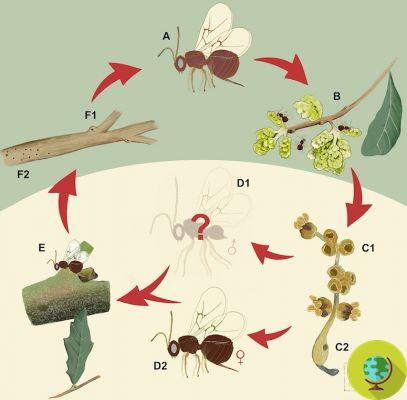The new species belongs to the family of bilious wasps, with anomalous behavior and not yet understood by scientists
He is about to end up run over, his mother saves himThe new species belongs to the family of bilious wasps, with anomalous behavior and not yet understood by scientists
Its name recalls that of the student pub "Rice Valhalla", just a stone's throw from Rice University (in Texas), because it was spotted there for the first time: it is the insect Neuroterus valhalla, a small wasp with no sting. Just a millimeter in size, it has the distinction of being the first insect to be described together with its fully sequenced genome, by Rice researchers.
The newly discovered species belongs to the biliary wasp family - known as the only insects capable of causing bile in the trees that host them: these wasps, in fact, "deceive" the tree in which they live and push it to produce nourishment and protection for their young (what we humans identify such as galls, growths that form on the leaves, inside the branches or in the flowers).
Basically, wasps create a mix of chemicals in which they lay their eggs: this mix protects the offspring and will feed the larvae when they hatch. After a period of about eleven months spent in this sort of cocoon, the larva sees the light and spends a period of two / three weeks inside the mix of nutrients in which it is immersed. As an adult, it has a life of only three or four days: it does not feed since its only purpose is to mate and lay new eggs.
What is striking in this species is the timing with which the moment of hatching coincides with the moment of flowering of the trees - this in order to have more places in which to reproduce and lay eggs: in fact, if the wasps come out of the cocoon at the wrong time and there are no flowers suitable for hosting the eggs, they die without having completed their reproductive mission. As different trees bloom at different times of the year, it is still unclear to scientists how insects "perceive" the perfect time to come out of their cocoons and reproduce.
Scientists believe that the climate can have a great influence on these small animals and their reproductive capacities: winter frosts and increasingly hot summers lead to irregular, early or late blooms, which will affect their symbiosis with the flowering of plants over time. . This could lead to the extinction of biliary wasps if they are unable to adapt to the changing climate.

@ Rice University
Follow your Telegram | Instagram | Facebook | TikTok | Youtube
Fonti: Systematic Entomology / Rice University
We also recommend:
- That's why we don't love wasps (even if they are important, just like bees)
- The Vespa velutina does not stop: the bee killer has also arrived in Genoa
- Bee, wasp or hornet stings: what really helps and useful tricks to avoid them


























